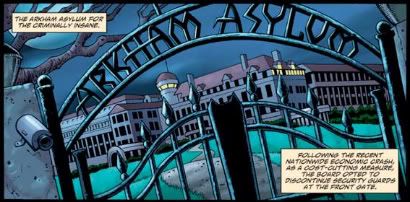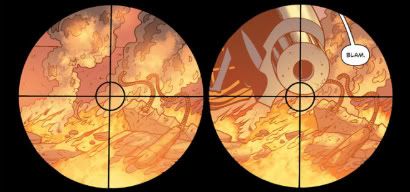This is what happens when you don't buy comics until Friday, or read them until Sunday.
*Yeah, I don't think the world is itching for another Batman #681 post at this very moment; there's plenty out there right now, and I doubt I'd have much of substance to say in a formal review. It was a rocky read (which was to be expected; I mean, when a monthly comic book storyline undergoes significant production delays and its final chapter then shows up with 10 or 11 extra pages appended out of nowhere, that's like a 9 out of 10 shot for antics behind the scenes), and it still didn't manage to resolve much.
And I don't even mean the plot - the whole running theme of 'Batman cannot escape his past, struggle as he might for evolution' sort of vanished, leaving an issue-length extrapolation on the Batman is Prepared for Anything trope that Morrison had already quite sufficiently explored in a prior issue when the whole back-up personality deal served as a funny plot point. It was an oddly straightforward issue, full of little anti-climaxes that seemed less purposeful than a means of locating the storyline's emergency exit.
I did like the Joker's parts; if he's the chaotic aspect of Morrison's narrative persona, it's pretty funny to have him concede to just sort of inventing the whole red/black motif out of stuff he half-remembered from somewhere else, only to get bumped out of the comic by an entirely silly coincidence courtesy of a different agent of chaos. Dr. Hurt's decidedly relaxed attitude toward supervillainy and its risks ("But you chose to be here") was good for a smile; I dunno if he's Old Scratch, but his super-nebulous nature casts him as the sheer idea of a Bat-villain, an every-villain, leading the jaded voyeurs of the Black Glove to their ruin via their own demands for wild, hero-killing kicks.
Hey - didn't this issue make the news for its hungry promise of Bat-killin'? Morrison was right that the Black Glove's identity was kinda obvious; he all but spelled it out (albeit in the abstract) in their first storyline last year, which cast the viewers as, well, maybe readers demanding more and better murders from their entertainment. If All Star Superman was filled with God and the sun and inspiration for the people, this one puts us all in league with devilry, possibly even complicit in keeping the hero married to the past. Surely Dr. Hurt's mission is of similar corruption to that going in Final Crisis, but here Morrison's solution boils down to superheroes outliving the whims of the monied public, maybe living across multiple publics in a big, long history. Which is all real, of course.
Still, none of these ideas particular cohere into much of a story, which is fine if you appreciate Morrison's allusions and weavings and such as their own overriding virtue, but it kinds of stinks at the end of the dramatic build the last few issues had been managing pretty well. And what of the big story? The evil future? Damian? If this was all leading up to Batman is Always Prepared against the worst corruption, with the entire supporting cast hustling in to save the day off-panel while a helicopter crashes and everyone scratched their heads, I can only conclude that this has been an awfully bloated, overextended mega-storyline indeed.
I dunno; maybe it's fitting that this thing looks to be ending as a tacit acknowledgement that the past keeps repeating itself and nothing quite resolves and we're not even bound to know who Batman is at the end, since this has been a segment of an ongoing series and a total history from the first issue, the battle continuing on and on and on... christ, this is more depressing than Seaguy! And I'm not even convinced it was supposed to be!
Oh well, two issues of finale to come, prior to the Bat-determining postscript, then a post-postscript, etc...
And I don't even mean the plot - the whole running theme of 'Batman cannot escape his past, struggle as he might for evolution' sort of vanished, leaving an issue-length extrapolation on the Batman is Prepared for Anything trope that Morrison had already quite sufficiently explored in a prior issue when the whole back-up personality deal served as a funny plot point. It was an oddly straightforward issue, full of little anti-climaxes that seemed less purposeful than a means of locating the storyline's emergency exit.
I did like the Joker's parts; if he's the chaotic aspect of Morrison's narrative persona, it's pretty funny to have him concede to just sort of inventing the whole red/black motif out of stuff he half-remembered from somewhere else, only to get bumped out of the comic by an entirely silly coincidence courtesy of a different agent of chaos. Dr. Hurt's decidedly relaxed attitude toward supervillainy and its risks ("But you chose to be here") was good for a smile; I dunno if he's Old Scratch, but his super-nebulous nature casts him as the sheer idea of a Bat-villain, an every-villain, leading the jaded voyeurs of the Black Glove to their ruin via their own demands for wild, hero-killing kicks.
Hey - didn't this issue make the news for its hungry promise of Bat-killin'? Morrison was right that the Black Glove's identity was kinda obvious; he all but spelled it out (albeit in the abstract) in their first storyline last year, which cast the viewers as, well, maybe readers demanding more and better murders from their entertainment. If All Star Superman was filled with God and the sun and inspiration for the people, this one puts us all in league with devilry, possibly even complicit in keeping the hero married to the past. Surely Dr. Hurt's mission is of similar corruption to that going in Final Crisis, but here Morrison's solution boils down to superheroes outliving the whims of the monied public, maybe living across multiple publics in a big, long history. Which is all real, of course.
Still, none of these ideas particular cohere into much of a story, which is fine if you appreciate Morrison's allusions and weavings and such as their own overriding virtue, but it kinds of stinks at the end of the dramatic build the last few issues had been managing pretty well. And what of the big story? The evil future? Damian? If this was all leading up to Batman is Always Prepared against the worst corruption, with the entire supporting cast hustling in to save the day off-panel while a helicopter crashes and everyone scratched their heads, I can only conclude that this has been an awfully bloated, overextended mega-storyline indeed.
I dunno; maybe it's fitting that this thing looks to be ending as a tacit acknowledgement that the past keeps repeating itself and nothing quite resolves and we're not even bound to know who Batman is at the end, since this has been a segment of an ongoing series and a total history from the first issue, the battle continuing on and on and on... christ, this is more depressing than Seaguy! And I'm not even convinced it was supposed to be!
Oh well, two issues of finale to come, prior to the Bat-determining postscript, then a post-postscript, etc...










